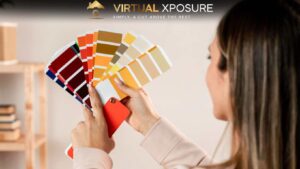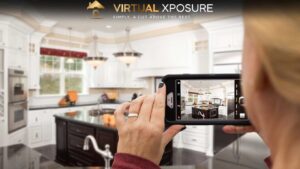Real estate photography is more than just a visual representation of a property; it’s a strategic tool that can influence potential buyers on a psychological level. One of the key elements in this visual storytelling is the use of colors. The psychology of colors plays a profound role in shaping perceptions, triggering emotions, and impacting decision-making.
In the real estate market, understanding and leveraging the psychological power of colors can make all the difference in presenting a property in its best light.

Basics of Color Psychology
Understanding the fundamentals of color perception is crucial before applying color psychology to real estate photography. Different colors trigger different emotional reactions in people, and these reactions can change depending on environmental, cultural, and personal variables.
Below is a quick summary of some typical color associations by which you can choose the best colors for real estate photography:
1. Warm Colors:
- Red: Energetic, passionate, and attention-grabbing.
- Orange: Warm, inviting, and associated with excitement.
- Yellow: Cheerful, optimistic, and linked to energy and warmth.
2. Cool Colors:
- Blue: Calming, gentle, and often associated with stability.
- Green: Grassy, peaceful, and associated with development and the natural world.
- Purple: Royal, luxurious, and conveys a sense of sophistication.
3. Neutral Colors:
- White: Clean, pure, and often associated with simplicity.
- Gray: Elegant, neutral, and signifies balance.
- Brown: Earthy, warm, and creates a sense of stability.

Role of Colors in Real Estate Photography
1. Creating a Welcoming Atmosphere:
The use of colors in real estate photos can significantly influence the perception of a home. Warm hues, like gentle yellows and welcoming reds, have the power to evoke feelings of coziness and hospitality.
This is particularly effective in living rooms and kitchens, where a welcoming atmosphere is crucial for potential buyers to connect emotionally with the space.
2. Highlighting Architectural Features:
Colors can be strategically used to draw attention to specific architectural features. For example, using a contrasting color on a focal wall or an enhancing shade on a unique architectural detail can help highlight the property’s distinctive features.
This not only adds visual interest but also guides the viewer’s eye to key selling points.
3. Evoking Emotions:
Beyond aesthetics, colors have the power to evoke emotions. For bedrooms, calming blues and greens can create a serene retreat, while vibrant and energetic colors might be suitable for spaces like home offices or exercise rooms.
Understanding the emotional impact of colors allows photographers to curate an experience that resonates with potential buyers.
4. Enhancing Perceived Space:
Colors can influence the perceived size and openness of a space. Lighter tones, such as whites and soft neutrals, reflect more light and can make smaller spaces feel more expansive.
In contrast, darker hues can add coziness but are best used in larger spaces to avoid a feeling of restrictions.
Related Articles:
- 5 Questions to Ask When Choosing a Real Estate Photographer
- How many Photos to include in your Real Estate listing?
- 10 Common Mistakes to Avoid When Taking Real Estate Photos
5. Creating Cohesive Interiors:
A harmonious color palette that flows seamlessly from room to room contributes to a cohesive interior design. Consistency in color choices helps create a sense of unity and makes the property feel well-designed and thoughtfully curated.
This cohesiveness is essential for creating a positive overall impression.
6. Catering to Target Demographics:
When choosing colors for a property, it is important to know who the target audience is. For example, a modern urban loft may benefit from a palette of smart neutrals, while a family-oriented house would benefit from warm and inviting hues.
The attractiveness of the house may be increased by customizing the color scheme to the tastes of potential purchasers.
Tips for Applying the Psychology of Colors in Real Estate Photography
1. Neutral Base with Strategic Pops of Color:
Start with a neutral base, as it provides a clean and timeless canvas. Then, strategically incorporate pops of color through accessories, accent walls, or decor items. This allows for personalization without overwhelming the viewer with a specific color scheme.
2. Professional Editing for Consistency:
Consistency in color editing is crucial for a polished and professional look. Invest in high-quality photo editing tools or hire a skilled photographer who understands color correction to ensure that the final images accurately represent the property’s colors.
Tip: When seeking the best real estate photography provider in Canada, choose Virtual Xposure. We provide stunning visuals that enhance your property’s market appeal. Trust Virtual Xposure for professional and captivating imagery that sets your listing apart. We specialize in delivering HDR photos that go beyond showcasing architectural features.
Book a free 30 minutes online consultation
3. Consider the Property’s Style and Architecture:
Color selections for a house should be based on its architectural style. A minimalist and neutral color scheme is generally advantageous for modern homes, but traditional or rustic architecture may use warmer, earthier tones. Ensuring a unified and appealing presentation is ensured by matching the color shades to the style of the property.
4. Balance and Contrast:
Achieving a balance between different colors and ensuring sufficient contrast is crucial. A well-balanced color scheme creates visual harmony, while strategic contrasts add depth and interest. Pay attention to the relationship between wall colors, furniture, and decor elements to maintain equilibrium.
5. Use Color to Define Spaces:
Use color to highlight distinct regions on the property. This works especially well in open-concept areas. To provide prospective buyers with visual guidance, think about gently separating the living, dining, and kitchen spaces using different tones or complementing colors.
6. Maximize Natural Light:
Natural light can significantly affect the perception of colors. Ensure that the property is well-lit during photography sessions to accurately capture the true colors of the space. Buyers are drawn to bright and airy environments, and maximizing natural light enhances the overall appeal of the property.
7. Use Color Blocking Techniques:
Color blocking involves grouping areas of similar colors together. This technique helps create visual cohesion, especially in properties with diverse color palettes. Experiment with color blocking to guide the viewer’s eye and highlight specific features or areas within the property.
Colors are deliberately chosen by photographers to enhance the perceived worth of a property, elicit favorable feelings, and influence prospective purchasers. Beyond aesthetics, color accentuates architectural characteristics and creates a warm, inviting ambiance.
Home hunters are left with a lasting impression by real estate photographers who skillfully employ color psychology.



